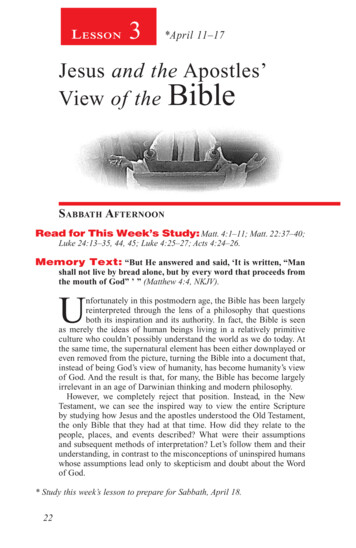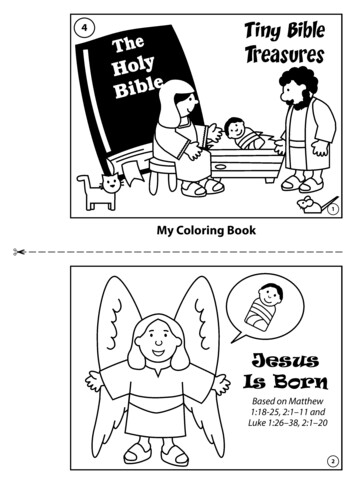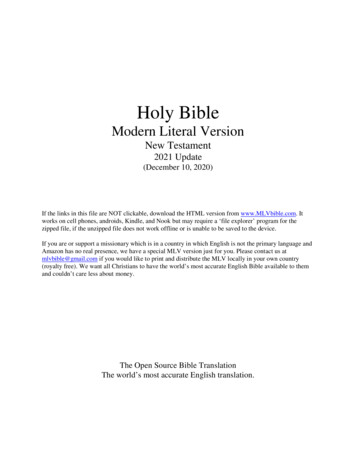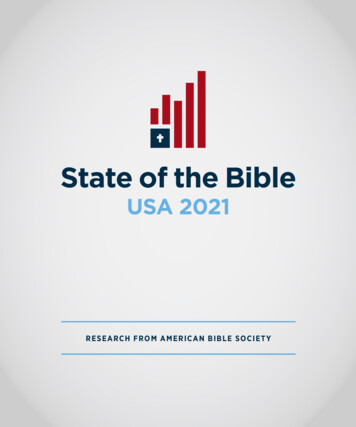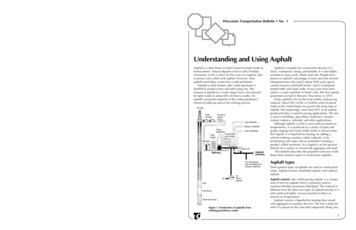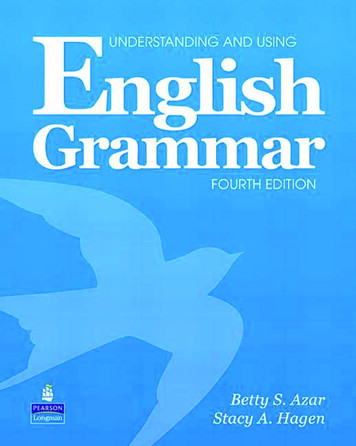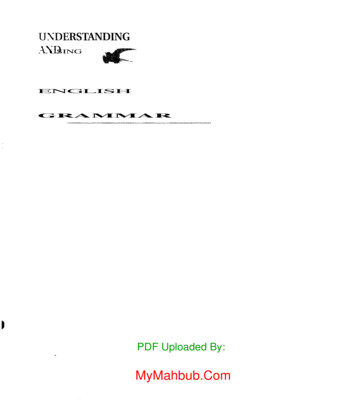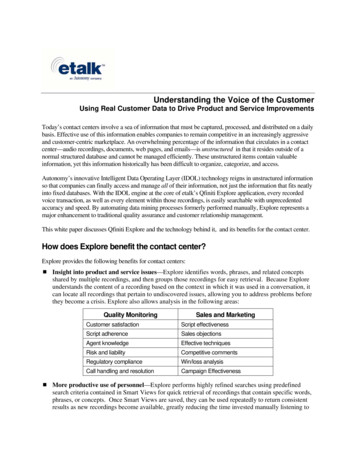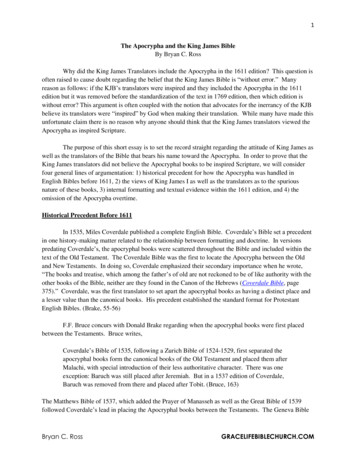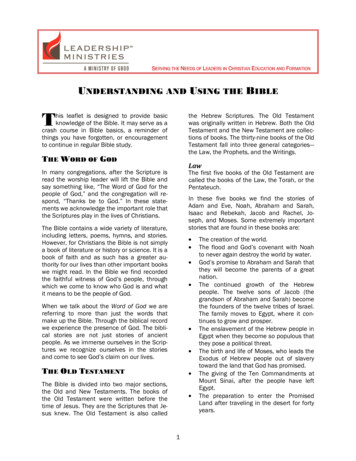
Transcription
SERVING THE NEEDS OF LEADERS IN CHRISTIAN EDUCATION AND FORMATIONUNDERSTANDING AND USING THE BIBLEThis leaflet is designed to provide basicknowledge of the Bible. It may serve as acrash course in Bible basics, a reminder ofthings you have forgotten, or encouragementto continue in regular Bible study.the Hebrew Scriptures. The Old Testamentwas originally written in Hebrew. Both the OldTestament and the New Testament are collections of books. The thirty-nine books of the OldTestament fall into three general categories—the Law, the Prophets, and the Writings.THE WORD OF GODLawIn many congregations, after the Scripture isread the worship leader will lift the Bible andsay something like, ―The Word of God for thepeople of God,‖ and the congregation will respond, ―Thanks be to God.‖ In these statements we acknowledge the important role thatthe Scriptures play in the lives of Christians.The first five books of the Old Testament arecalled the books of the Law, the Torah, or thePentateuch.In these five books we find the stories ofAdam and Eve, Noah, Abraham and Sarah,Isaac and Rebekah, Jacob and Rachel, Joseph, and Moses. Some extremely importantstories that are found in these books are:The Bible contains a wide variety of literature,including letters, poems, hymns, and stories.However, for Christians the Bible is not simplya book of literature or history or science. It is abook of faith and as such has a greater authority for our lives than other important bookswe might read. In the Bible we find recordedthe faithful witness of God’s people, throughwhich we come to know who God is and whatit means to be the people of God.The creation of the world.The flood and God’s covenant with Noahto never again destroy the world by water.God’s promise to Abraham and Sarah thatthey will become the parents of a greatnation.The continued growth of the Hebrewpeople. The twelve sons of Jacob (thegrandson of Abraham and Sarah) becomethe founders of the twelve tribes of Israel.The family moves to Egypt, where it continues to grow and prosper.The enslavement of the Hebrew people inEgypt when they become so populous thatthey pose a political threat.The birth and life of Moses, who leads theExodus of Hebrew people out of slaverytoward the land that God has promised.The giving of the Ten Commandments atMount Sinai, after the people have leftEgypt.The preparation to enter the PromisedLand after traveling in the desert for fortyyears.When we talk about the Word of God we arereferring to more than just the words thatmake up the Bible. Through the biblical recordwe experience the presence of God. The biblical stories are not just stories of ancientpeople. As we immerse ourselves in the Scriptures we recognize ourselves in the storiesand come to see God’s claim on our lives.THE OLD TESTAMENTThe Bible is divided into two major sections,the Old and New Testaments. The books ofthe Old Testament were written before thetime of Jesus. They are the Scriptures that Jesus knew. The Old Testament is also called1
ProphetsWritingsTwenty-one books in the Old Testament makeup the Prophets. The Prophets are not foundin chronological order in the Bible but are intermixed with books that fall in the Writingscategory. In the Prophets we see the continuing story of God’s people. In some of the important stories in these books,The Writings include several different types ofliterature. Several books in this category arepoetry. Perhaps best known in this group ofbooks is Psalms. The psalms are poems andhymns that were used in worship. Some of theWritings include wise sayings, while others tellthe stories of people’s experiences with God.Some of the well-known stories, poems, andproverbs found in the writings are:Joshua leads the Hebrew people into thePromised Land.Psalm 23. This is the psalm that hasbrought comfort to people throughout theages. It begins with ―The LORD is my shepherd,I shall not want.‖The Hebrew tribes struggle to form a newsociety that is ruled by God. The leaders during this time are called judges.The people begin to want to be like othernations and demand a king. Saul becomes thefirst king of Israel.The story of Esther, the Jewish womanwho becomes queen and through wisdom andcourage is able to save her people from destruction.Saul becomes a weak king. David ascendsto power as the second king of Israel.The story of Job, a man who remains faithful to God even though he experiences manytribulations.David’s son Solomon becomes the thirdking of Israel. Under Solomon’s leadership theTemple is built in Jerusalem.Proverbs 15:1, ―A soft answer turns awaywrath, but a harsh word stirs up anger.‖ This isone example of the many wise sayings thatare found in the Book of Proverbs.The Old Testament was first an oral work,put in written form over the span of severalcenturies. The earliest writing dates fromabout the 8th C B.C., though it refers to eventsseveral centuries before. The last of the bookswas written around the 2nd C B.C.Ecclesiastes 3. This is the poem that begins, ―For everything there is a season, and atime for every matter under heaven.‖The Song of Solomon. This is a book oflove poetry.The story of Ruth, the non-Jewish womanwho becomes the great-grandmother of KingDavid. In Ruth 1:16 we find the well-knownpassage ―Where you go, I will go; where youlodge, I will lodge; your people shall be mypeople, and your God my God.‖After Solomon’s death Israel divides itselfinto two smaller kingdoms, Israel and Judah. Aseries of kings reigns, many of whom fall awayfrom God.Prophets warn the people of Israel andJudah that destruction will come if they do notreturn to God.THE NEW TESTAMENTThe New Testament was written, in Greek, after the death and resurrection of Jesus. Thereare twenty-seven books in the New Testament. They can be divided into four categories—gospels, history, letters, and revelation.The Kingdom of Israel falls to the Assyrians, and many of the people are exiled toAssyria.Two centuries later, the Kingdom of Judahfalls to Babylon, the Temple in Jerusalem isdestroyed, and many are exiled to Babylon.GospelsThe first four books of the New Testament(Matthew, Mark, Luke, and John) are calledthe Gospels. The word gospel means goodSome of the people return from exile andbegin to rebuild the Temple.2
news. The Gospels contain the good news ofJesus Christ, an intention stated plainly inMark: ―In the beginning of the good news ofJesus Christ, the Son of God‖ (Mark 1:1).RevelationThe Book of Revelation was written at a timewhen the church was being persecuted by theRoman Empire. It was dangerous to speakforthrightly about the Christian faith or to criticize the government. Much in the same waythat African American slaves in the nineteenthcentury hid the directions for escaping in stories and songs, the Book of Revelation usessymbolic language to talk about faith. Although written during a specific time of persecution, its basic message that God reigns supreme and that Christ has the power to overcome all evil is important for Christiansthroughout the ages.In these books we find the stories of Jesus’birth, life, death, and resurrection. We alsofind the stories that Jesus used when hetaught his disciples and others who came tohear him. These stories are called parables.They help us to understand what God is likeand how God wants us to live.Some of the stories in the Gospels are foundin only one of the books while other storiesare found in more than one of the Gospels.For example, the story of the wise men visitingthe baby Jesus is only found in the Gospel ofMatthew, while the story of Jesus driving themoney changers out of the Temple is found inall four Gospels.The writing span of the New Testamenttook less than a century, starting withthe letters of Paul, around 50 A.D., thenthe Gospels (about 70—90 A.D.). The lastof the books was written by about 120—135 A.D.HistoryThe Acts of the Apostles was written by thesame person who wrote the Gospel of Luke.Acts tells the story of the coming of the HolySpirit and the formation of the early churchafter Jesus’ resurrection. In this book we seehow the Christian church spread from its beginnings in Jerusalem all the way to Rome. Italso tells how the apostle Paul came to be aChristian.FINDING A BIBLE PASSAGESome people are good at remembering Biblereferences, but most of us are not. Whensomeone says, ―This is similar to what Jesussaid in Luke 11:2,‖ we don’t have any ideawhat statement the person is referring to. Butthat doesn’t matter, because we have beengiven the information we need to find the passage in the Bible.LettersMost of the books in the New Testament areletters that were written to various churches tooffer encouragement, help with problems, andpass along Christian teaching. The letters (also called epistles) frequently talk about particular issues that were facing the church. Thetitle of each book often gives an indication ofwhat church the letter was originally writtento. For example, the Book of Romans was written to the church at Rome. Because these letters contained important information, theywere not only read aloud in the church theywere sent to but also copied and passed alongto other churches.Bibles use different size pages and differentsizes of print, and there is no standard number of pages in the Bible. That is why we use aBible reference rather than a page numberwhen communicating where a Bible passageis found.When locating a passage the first thing to determine is what book the passage is in. Inmost Bibles there is a table of contents at thebeginning. The Old Testament will be listedfirst, followed by the New Testament.Many of the letters were written by, or attributed to, the apostle Paul. Even though theseletters are found in the middle of the New Testament they were actually the first books ofthe New Testament to be written.A few books in the Bible have the same name.For example, there are four books in the NewTestament that are all called John. The Gospelof John is referenced as John and the othersare referenced as 1 John, 2 John, and 3 John.3
When speaking we refer to them as First John,Second John, and Third John.Using a ConcordanceIf you know some of the words in a Bible passage but do not know where it is located, youcan use a concordance to help find it.Many Bibles begin numbering the first page inthe Old Testament (Genesis) with 1 and thenbegin the numbering system again with page1 on the first page of the New Testament(Matthew), so it is also important to identifywhich Testament the book is found in.A complete concordance lists all of the wordsin the Bible and tells you which passages include that word. If you wanted to find theverse that says, ―And now faith, hope, andlove abide, these three; and the greatest ofthese is love,‖ you could look in a concordance under the words abide, hope, greatest,or any of the other words in the verse to discover that this is found in 1 Corinthians13:13.Chapter and verse numbers were not included in the original biblical texts. Theyhave been added, as have the subheadingsthroughout the chapters, for ease of use bymodern readers.Some Bibles include an abbreviated concordance. While it won’t help you find every passage in the Bible, it can often help you findsome of the most frequently used passages.After finding the book the passage comesfrom, the next step is to locate the chapter.The chapter is indicated by the number that islisted directly after the book. Using the example of John 10:7-9, we would want to find thetenth chapter of the book of John.John 10:7-97Soagain, Jesus said to them, “Very truly, Itell you, I am the gate for the sheep. 8All whocame before me are thieves and bandits; butthe sheep did not listen to them. 9I am thegate. Whoever enters by me will be saved andwill come in and go out and find pasture.”In most Bibles the chapters are indicated atthe top of each page. The beginning of thechapter is usually indicated with a large number immediately in front of the first sentencein the chapter. Each book begins with chapterone. A chapter may cover less than one pageor several pages. Some books of the Biblehave only one chapter; others have several.DIFFERENT TRANSLATIONSChapters are divided into smaller sectionscalled verses, which are usually indicated by asmall superscript number just before the firstword of the verse. In a biblical reference theverse or verses follow the chapter number andare separated from the chapter number by acolon. The biblical reference John 10:7-9means the Book of John, chapter 10, verses 7through 9.Because neither the Old Testament nor theNew Testament was originally written in English, the Bibles that we use are translations.The first (Middle) English translations of theBible were made as early as about 1250,though the Bibles we know, with chapter andverse designations, originated with the Geneva Bible in the mid-1500s.We sometimes identify a Bible passage usinga lowercase a or b after the verse numberwhen we want to include only part of an entireverse that is divided by a semicolon or period.(The lower case letters are not shown in theBible; just in reference to that passage.) Forexample, John 10:7-9a indicates that the passage begins with verse 7 and ends with thefirst sentence in verse 9, at the words ―I amthe gate.‖The Geneva Bible was used as the basis of the―Bishop’s Bible,‖ a product of the Church ofEngland, published in 1568 and revised in1572. This translation placed greater emphasis on the original languages than relying onLatin translations and early versions of theBible. In the Early 1600s, the popular KingJames Version was commissioned as a revision, mainly of the Geneva Bible and Bishop’s4
Bible, as the authorized text. In the years between, the Roman Catholic Church had commissioned its own work, the Reims version.BIBLE REFERENCE BOOKSIn addition to a concordance, there are several Bible reference tools that will help you explore your Bible. Remember, however, thatthey are just tools. Reading about the Bible ishelpful but can never replace actually readingthe Bible.Up until 1947 the earliest known existing Hebrew manuscripts of the Old Testament camefrom around the ninth century A.D. Rememberthat before the invention of the printing press,manuscripts had to be copied by hand, a verydifficult task.Bible AtlasThe Bible encompasses thousands of years ofhistory. As time passed, cities rose and fell,new nations were formed, and boundariesbetween nations changed. A Bible atlas contains maps of Bible lands at various times inhistory. For example, if you wanted to knowwhere Nazareth (Jesus’ hometown) was located, you would look at a map of Palestine inNew Testament times. Nazareth would probably not appear on a map of the same regiondepicting the time of Abraham.However, in 1947 a shepherd boy discoveredsome ancient scrolls near the west shore ofthe Dead Sea. Over the following years morescrolls were discovered. These scrolls, whichdate from mid–third century B.C. to mid–firstcentury A.D., include all of the books of the OldTestament except for the Book of Esther.In the past two hundred years many moremanuscripts of the Greek text of the New Testament have been found. Many of these manuscripts are older than those used by theKing James revisers, and scholars believe theyprovide us with a more accurate picture of theoriginal text than was available at that time.Sometimes you will find a simple Bible atlas atthe back of your Bible. Your church library mayhave a more complete Bible atlas.Bible DictionarySuppose that while reading your Bible you encountered the phrase from Psalm 104:26,―There go the ships, and Leviathan.‖ Wouldyou know what the Leviathan was? If not youcould go to a Bible dictionary for help. Wordsare listed alphabetically and you look them upin the same way you look up words in a regular dictionary.Excerpt from a ConcordanceGreatestJob 1:3:Mark 9:34Acts 8:101 Cor. 13:13this man was the greatest of allwho was the greatest.from the least to the greatest.the greatest of these is love.Some Bible dictionaries will give a short definition of the word you are looking up. Other Bible dictionaries will have an article that mayinclude extensive information about the history of the word and its significance in the Bible.You can use a Bible dictionary to look uppeople, places, and events.The discovery of the Dead Sea Scrolls andolder and more numerous Greek manuscripts,as well as newer knowledge about languageand word usage in Bible times, has led to anumber of newer Bible translations. One ofthe most frequently used translations is theNew Revised Standard Version, which waspublished in 1989. Other well-known translations include the New International Versionand the Contemporary English Version.CommentaryA commentary is a book that gives additionalinformation about biblical passages. For example, if you were reading the story of Jesus’birth in Luke 2 and wanted to find out whatbiblical scholars thought about this passage,you could turn to a commentary on the Bookof Luke. Usually the biblical references arelisted at the top of the page. Most commentaries will describe what is happening in theSometimes a Bible is not translated fromGreek and Hebrew but is a paraphrase, a retelling of the Bible in the author’s own words.Some children’s Bibles are paraphrases ratherthan translations. One well-known paraphraseis The Message.5
passage, will provide some historical background, and will offer interpretive thoughtsabout the significance of the passage.Use a Variety of ResourcesSelect a Bible passage. Read it in several different translations. Think about what the passage says. Use a Bible dictionary to help youunderstand any unfamiliar words.Some commentaries are written on just onebook of the Bible while others cover severalbiblical books in one volume. At times you maywant to refer to more than one commentary toget a variety of interpretations.Discuss what the passage meant to thepeople in Bible times who originally heard it.Use other Bible reference books to help youunderstand what the historical and culturalconditions of the time were. Locate placesmentioned in a Bible atlas.WAYS TO STUDY THE BIBLEBible study is often referred to as a means ofgrace. This means that Bible study is onechannel through which we experience God’slove. It is a spiritual practice or discipline thathelps us grow as disciples—people who loveGod and love their neighbors.Discuss what meaning the passage has for ustoday. Determine if there are changes thatneed to be made in your own life, based onthe message of the passage.Use Your SensesListen as someone reads a Bible story severaltimes. As you listen to the story imagine thatyou are one of the characters in the story.Each time the story is told focus on one ofyour senses. What are you hearing? What areyou seeing? What do you taste? What do youfeel? What do you smell? Discuss what youexperienced.Sometimes we study Scripture for guidance inparticular situations, sometimes we use Scripture as a way to focus and direct our prayers,sometimes we study Scripture to draw courage and understanding from faithful peopleof the past, and sometimes we study Scriptureto learn the teachings of Jesus.Excerpt from a Bible DictionaryParaphrase the ScriptureLeviathan (li-vi -uh-thuhn)A leviathan is a sea serpent or a dragon. In theBible it is sometimes used to represent chaos. Itcomes from a word meaning “twisting one”(see, for example, Job 41:1 or Psalm 104:26).Illustrate the ScriptureChoose a Scripture passage and then paraphrase the passage in your own words. As youwrite the paraphrase think about what theScripture means for your own life.Read a Bible passage and then in some waydepict a key scene from the story. Another wayto illustrate the story is to draw a picture as ifthe story were occurring in modern times. Instead of actually painting a picture of thescene, you could use a different medium,such as crayons, pencils, chalk, markers, ormodeling clay, to create a picture that reflectshow the passage makes you feel. Use of otherarts, such as photography, could also be employed creatively.It is helpful to have an intentional regular planfor Bible study. For some this means becoming part of a Bible-study class or group. Forothers it means setting aside a particular timeeach day to engage in Bible study. There aredevotional books available that will suggest aparticular Scripture for each day. Some peoplechoose a particular book of the Bible to study,reading a little each day. Many teachers usethe Scripture that their curriculum is based onto guide their Bible-study plan.Keep a JournalEach day after reading a Bible passage, reflecton the passage in a journal. Record insightsyou gained from the passage. Reflect on waysthat your own life relates to the passage. Consider what you think God is trying to say to youthrough the passage.Using different methods of Bible study willhelp you to experience the power of the Scriptures in new ways. Following are several suggestions for Scripture study.6
particular challenges in finding opportunitiesfor Bible study. Classes may be offered at theexact same time that you are teaching.Pray the ScripturesQuiet your body and mind and anticipate listening for God. Read a Scripture passage orlisten as someone else reads a passagealoud. Sit quietly, opening yourself to God’spresence.However, many churches offer classes orgroups at times other than Sunday morning.The DISCIPLE Bible study program is offered inmany churches. It begins with a thirty-fourweek study that includes both the Old andNew Testaments. DISCIPLE involves daily Biblereadings and a weekly class.GOING FURTHERThe Bible is filled with powerful stories thathave many layers of meaning. As we grow andmature in our faith we encounter God in newand challenging ways in old familiar passages.For example, for children the significance ofthe story of Jesus’ birth may be that Jesus wasonce a child himself. As we grow older the story takes on deeper meaning and raises newquestions for our lives. What does it meanthat God appeared in human form? How doesknowing that the Son of God was first announced to poor people change the way I relate to other people? How is the angel’s message to the shepherds also a message to me?Some churches offer a mid-week lectionarygroup in which the participants study theScripture that will be preached on in the following Sunday’s worship service. A lectionaryis a calendar of suggested Scripture readings.Most lectionaries include a reading from theOld Testament, a reading from the Gospels, areading from the Epistles, and a psalm. Manypastors use The Revised Common Lectionaryto guide worship planning. The Revised Common Lectionary is based on a three-year cycle.If you have ever talked with a friend whosepastor preached about the same Scripture onthe same day as your pastor did, then it is likely that both pastors were preaching from thelectionary.As you become more familiar with your Bible itis likely that you will experience a thirst todrink even more deeply from the wells of itswisdom and truth. As a teacher you may face For another article on understanding the Bible, see ―De-Mystifying the Bible (at Least, a Little t3.aspx?c nhLRJ2PMKsG&b 5572389&ct 7304543 This pamphlet is prepared by the Faith Formation and Discipleship Groups atthe General Board of Discipleship of The United Methodist Church and may be reprinted for use in the local church 2010 GBOD.For more information about the needs and requirements in specific ministry areas, see the leadership seriesGuidelines for Leading Your Congregation, which includes Christian Education Children’s Ministries Youth Ministries Adult Ministries Family Ministries Small Group MinistryGo to www.cokesbury.com or call 1-800-672-1789. Please also visit our website www.gbod.org7
BOOKS OF THE BIBLE, BY TYPEBOOKS OF THE OLD myPROPHETSJoshuaJudges1 Samuel2 Samuel1 Kings2 WRITINGSPsalmsProverbsJobSong of aDaniel1 Chronicles2 ChroniclesBOOKS OF THE NEW TESTAMENTGOSPELSMatthewMarkLukeJohnHISTORYActs of the Apostles1 Thessalonians2 Thessalonians1 Timothy2 TimothyTitusPhilemonHebrewsJamesLETTERSRomans1 Corinthians2 CorinthiansGalatiansEphesiansPhilippiansColossians 2010 GBOD. This page may be reproduced for use in the local church.81 Peter2 Peter1 John2 John3 JohnJudeREVELATIONRevelation
first, followed by the New Testament. A few books in the Bible have the same name. For example, there are four books in the New Testament that are all called John. The Gospel of John is referenced as John and the others are referenced as 1 John, 2 John, and 3 John. The writing span of the New
